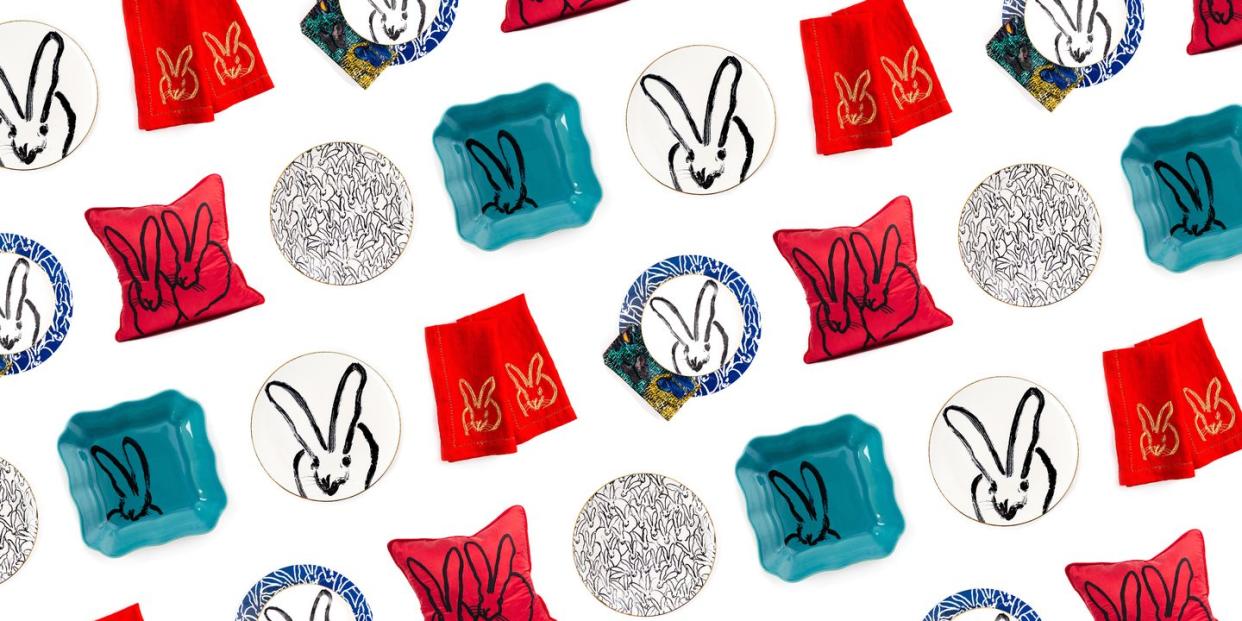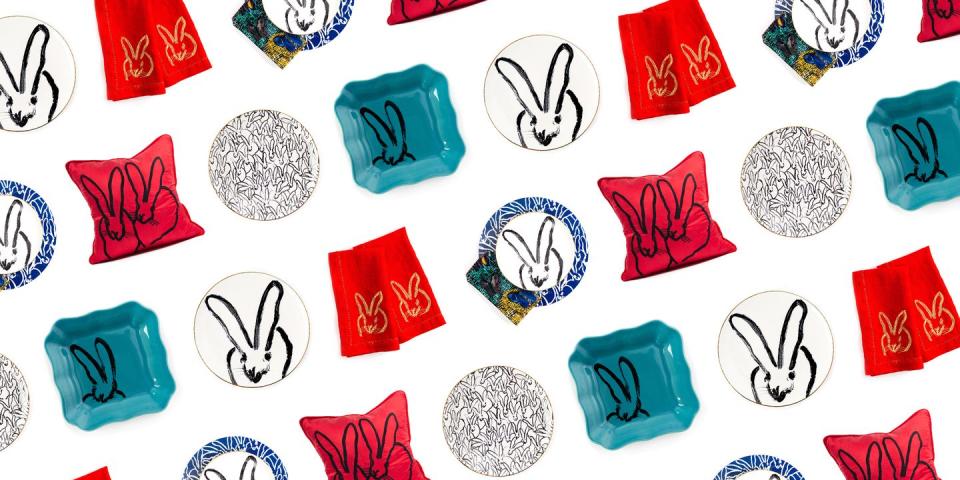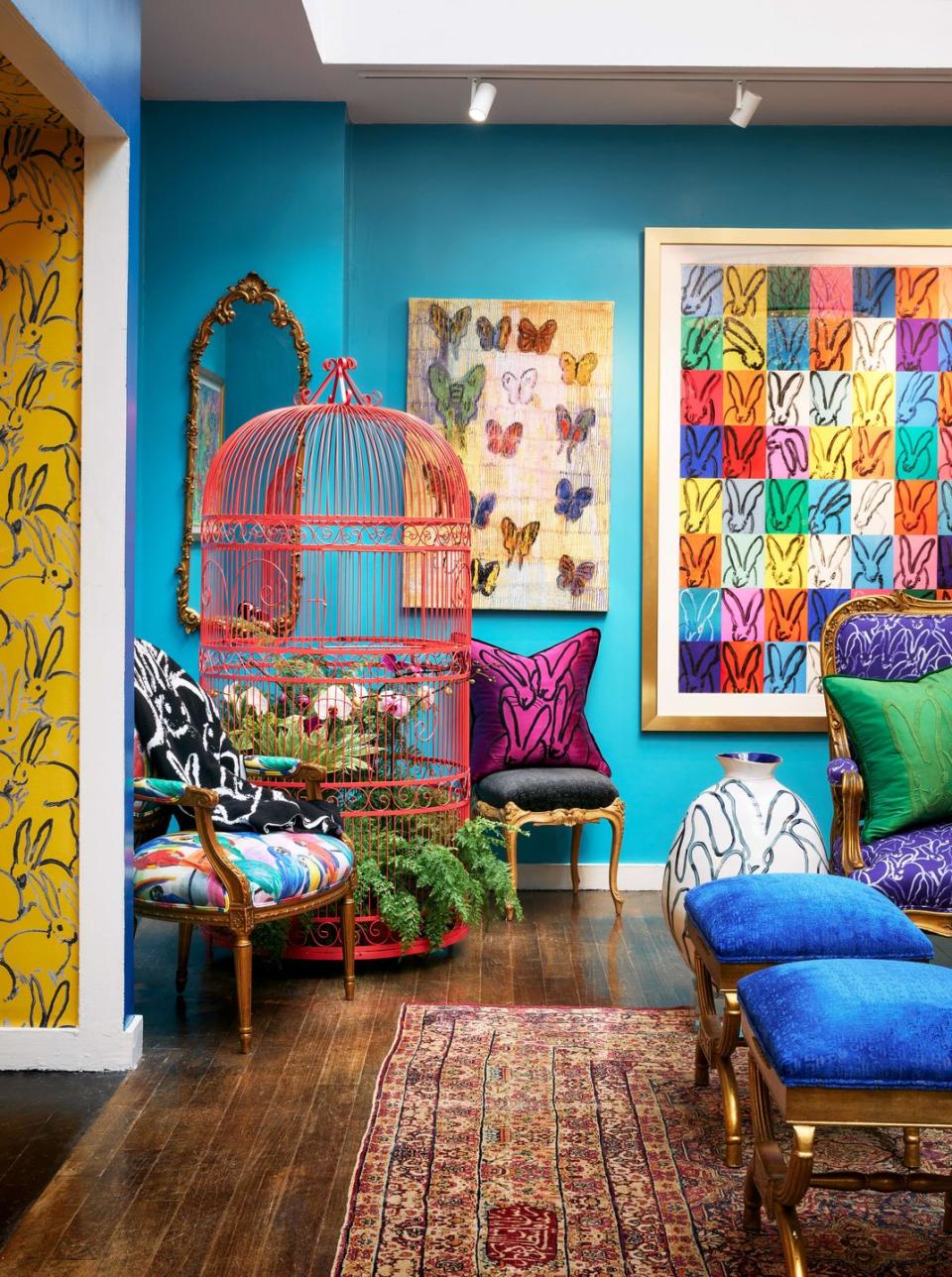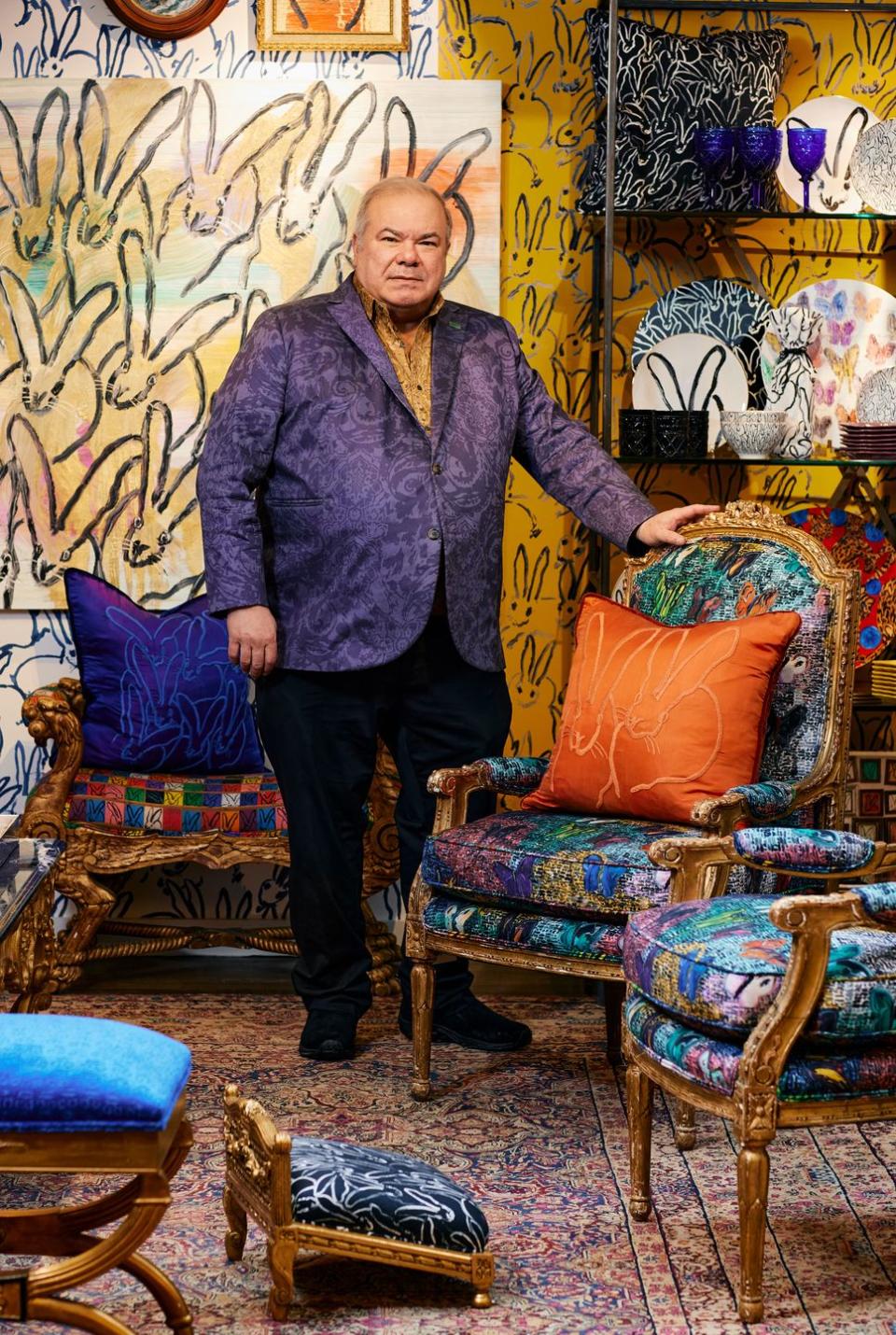Artist Hunt Slonem Brings a Vibrant Menagerie of Birds and Bunnies to Bergdorf Goodman

- Oops!Something went wrong.Please try again later.
It was four o'clock in the morning when artist Hunt Slonem first saw a pair of socks with Edward Hopper’s "Nighthawks" on them. "I had just moved to New York," he tells me over the phone, "and I thought that was terrific."
At the time, he says, creating commercial products with artwork on them was still risky for painters. "It was not considered something you should do when I first came here," he explains. "The Metropolitan Museum has been doing it forever," but usually, he laments, works are only adapted after an artist is dead. "I'd rather have my 2 cents put in while I'm alive."
So Slonem created a line of luxe accessories and home decor—everything from napkins and trinket boxes to bedsheets, cereal bowls, and throw pillows—featuring his signature rabbits, birds, and butterflies (and the occasional portrait of Abraham Lincoln). And for those who have always coveted a Hunt Slonem original but couldn't afford the price tag, each piece costs much less than a painting.
Just in time for Easter, Slonem's bunny-filled "Hop Up Shop" opens at Bergdorf Goodman in the 7th floor Loft space and on BG.com as well as in specialty stores and galleries throughout the country. Here, the artist speaks a bit about the collection, but also his love of nature, how the pandemic has impacted his painting process, and why he finds Queen Elizabeth so fascinating.

To start, why rabbits? Why are they so prolific in your art?
It's just my gesture. It's how I start my day. They're kind of my warmup paintings. I've been doing them since the '70s probably. And it just has lasted and grown and developed into everything from neon sculpture, to bronze, to glass works. I believe in using a subject matter a lot and taking it on.
I also grew up with rabbits. A rabbit test is how you determined if somebody was pregnant in the '50s, and lucky charms, with the rabbit's feet. Thank God we don't do anymore. And then I discovered that I'm the sign of the rabbit in the Chinese zodiac, but I was just doing them anyway.
It started out with my paintings of saints, and I often put rabbits at the feet of the saint, for reasons I can't even tell you. I just like the groupings and the way they work together. It's just something that sticks. Sometimes the simplest thing that you do is the greatest thing you do.
Anyway, I've lived and worked with birds more of my life than rabbits, but the rabbits really have an appeal that I never suspected would happen. And it's just ongoing, and I love doing it, and it's my daily ritual.
Tell me more about the birds. What do you like most about them?
Everything! The way they move, where their plumes are placed, the colors, the way that so much has been inspired by them, the way they seem to come to represent the human soul in most forms of religions. They just captivate me. I can't tell you why I relate to them very well. They're very smart for one thing. So they're good companions when I paint, and I talk to them and ask them questions. It's great companionship for a solitary endeavor.
Beyond your work that’s inspired by nature, I know you’ve painted Queen Elizabeth many times. T&C are fascinated by her.
Well, who isn't?
Why do you find her interesting to paint?
She's so much a part of our lives. People, including me, are so smitten by her, and I just admire her even-keeled-ness, how through all of it, she's done what she thought she should, right or wrong, and the tradition of a lineage. It's just the last vestige of another world, and I've seen her over the course of my life. I was at the investiture of Prince Charles, when he was made Prince of Wales, by chance.
I don't know, it's just always been around. It's just one of those inexplicable fascinations. I mean, presidents come and go, and monarchs often do, but she's still with us. And it's kind of terrific to me, something deep rooted and endlessly fascinating.
In the past you've described your painting as meditative. What do you mean by that?
I'm referring mostly to my mark-making. I make marks with the back of the brush into the wet paint, which I call crosshatching, but there's no real term for it. So I use the brush to paint the painting, and the back of the brush whittled to a point, to carve into it.
In making the marks, I often say mantras, or repeat holy things. And this whole idea of repetition and repeated imagery seemed to all add up to a state of channeling or meditation and something that's beyond the conscious self.
We're approaching a year into this pandemic.
Ugh.
I know. How has your process and work shifted over this past year?
It's much more concentrated. There used to be a lot of travel and going out and studio visits by the dozens, and all that's quieted. Even though I continue to have shows all over the place, I'm just not going to the openings.
So it's given me a lot of contemplation time and introspection and not jumping mindlessly from thing to thing. I revisited a lot of earlier ideas I had. Just trying to be more introspective and meditative and learn to look within rather than without. It's been a real challenge a lot, I'm sure, for most people.
I really didn't leave my studio for a few months in the beginning, since we were having such a rough patch and nobody was coming in. It's been pretty extreme. Anyway, it's been good for the art, and all my sculpture projects have come about during this period of time. I'm doing glass and bronze and neon and mosaics, a lot of new exploration.

What are you most looking forward to, when we get somewhat back to normal?
Well, that's a big if. I'm not hating things as they are. Maybe I'm hating how frantic everything was before, and it's a significant chunk of your life at a certain age, although I'd rather be going through it at this age than much younger. I'm grateful that I traveled so enormously earlier. I'm loving my solitude and my prayerful times, and what little social life there is, is great.
Anyway, I think we're easing into a new phase, but I don't know where it's going to go. And I'm completely content with my life either—well, I don't want to say either way. I really want to be able to walk around without a mask. I guess the masks are the hardest part of it for me. And [I'd like to] just to gather with people, to see friends. It's been so strange. But anyway, we're all still smiling, I hope.
People are spending so much more time at home right now, appreciating their surroundings.
Right. It's been very good for me. It's been a very lucrative time for me. I get feedback constantly, [people sending me images] of the placement of my work. It plays a huge role in so many people’s lives.

What made you want to expand into products, like this line at Bergdorf’s?
Why not? There were socks that I saw at 4 o’clock in the morning, when I first moved to New York, that had Edward Hopper’s “Nighthawks” on them, and I just thought that was terrific. Everybody's always put art on t-shirts and whatever. There's been a real run of fashion and art collaboration, Keith Haring had the Pop Shop.
It was not considered something you should do when I first came here, but now a lot of galleries have products and things that their artists have done. And usually for people, this happens to them after they die. So I'd rather have my 2 cents put in while I'm alive and make a total environment out of it.
My studio is awfully important to me, as part of my work. And I've done many museum shows of recreating the studio and mingling the paintings and things and frames and furniture and color. It's really a play of color and form that is like a painting to me. That's the way it all adds up.
Do you have a favorite piece in the collection?
Oh, I love all the bed clothing. I like all of it. I think it's great. I mean, there's plenty more we could do, but this is a great beginning.
You Might Also Like

